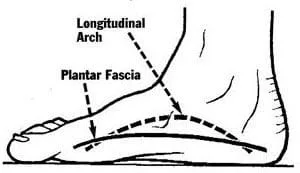
The plantar fascia is a broad band of fibrous tissue on the bottom of the foot. It starts at the base of the heel bone (calcaneus) and stretches to the base of the toes. Its primary function is to support the arch. The plantar fascia acts like a shock absorbing bowstring, supporting the arch and the foot. Problems can occur when part of the plantar fascia is repeatedly placed under tension. If the tension on the plantar fascia becomes to great, small tears in the plantar fascia can occur which leads to inflammation and pain. Eventually, a heel spur can form.
There are many factors that can lead to the onset of plantar fasciitis: These include:
- tight calf muscles
- excessive time on your feet (i.e. over use)
- obesity
- improper shoes
- flat-footed or high arched
- pronation
- certain types of arthritis.
Pronation is the rolling inward of the foot during the gait cycle. Excessive pronation decreases the stability of the foot bones and increases the tension on the plantar fascia.
Regardless of the mechanism of injury, the result is that the strained fascia becomes inflamed and persistent pain follows. Your podiatrist will exam your feet and determine the appropriate treatment plan for your condition.
